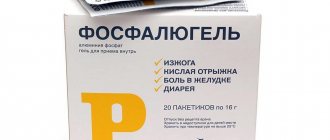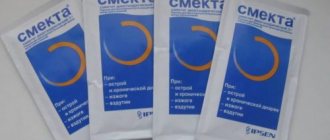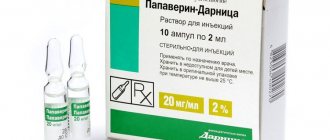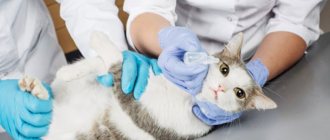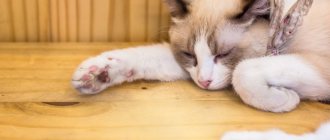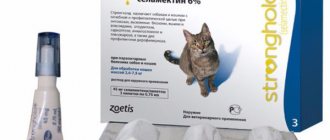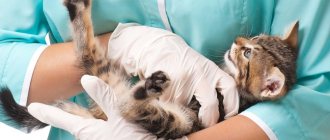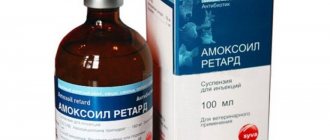6664Pavel
Many breeders are in no hurry to contact qualified veterinary clinic specialists at the first signs of diarrhea in their pet, preferring to self-medicate. After all, the famous Furazolidone for cats often becomes a real salvation in such a situation. However, diarrhea in your beloved pet clearly indicates a disruption in the digestive tract. It is a mistake to assume that with such an illness the cat is completely safe and its condition is not critical.
Chemical composition
The composition of the drug "Furazolidone" includes the active substance of the same name in an amount of 50 mg. The following additional elements are also added to the tablets: potato starch, lactose monohydrate, colloidal anhydrous silicon dioxide, potassium stearate.
The product is produced in Russia, Belarus, and Ukraine. Since it is used both in medicine and veterinary medicine, you can buy it in a regular pharmacy chain.
Did you know? The oldest remains of a domestic cat to date have been found in Cyprus. Archaeologists date them back to 7500 BC. e. The animal was buried along with the person.
Description of the product
Furazolidone is classified into the group of new generation antibacterial agents of the nitrofuran class.
It has a broad halo of influence and is highly effective in combating bacteria. Release form: yellow tablets of 0.05 grams or light yellow powder with no odor. Used only for oral administration. It is used in poultry of various breeds, calves, pigs and other farm animals.
The main active ingredient contained in the medication is furazolidone (50 grams). Additional substances in the composition: potato starch, lactose, Tween80, calcium stearate, sucrose.
It is worth noting that if the drug is dosed correctly, it will not contain components or toxins dangerous to avian and animal organisms. The product belongs to the category of products with low toxin content. Does not have teratogenic, carcinogenic or irritating effects.
Furazolidone is intended for meat chickens and adults for the purposes of prevention and treatment.
Based on the instructions, the drug can be stored in a dry and fairly cool place. It is important to protect it from direct sunlight. Storage should be carried out in the original packaging. Temperature range from five to twenty degrees. The shelf life of the product in tablet form is three years, the powder is stored for no more than two years from the date of manufacture.
Is it possible to give a kitten "Furazolidone"
Since small kittens have a fragile immune system, infectious processes develop at lightning speed, and diarrhea can lead to dehydration in the shortest possible time, they cannot be treated independently.
“Furazolidone” is not used in veterinary practice for kittens, since it is difficult to divide the tablet according to small weight and there is a high risk of overdose. If you feel unwell, you should immediately seek veterinary help to avoid serious consequences for the baby’s health. Based on examination, symptoms and tests, the veterinarian will determine the cause of the kitten’s illness and prescribe effective treatment.
Application, overdose, interaction
Furazolidone is recommended for many infectious diseases:
- infectious gastrointestinal diseases: dysentery, cholera, food poisoning, infectious diarrhea, paratyphoid;
- for pyelitis, urethritis, cystitis;
- for parasitic diseases (giardiasis, trichomoniasis);
- for wounds, burns, frostbite.
The principle of action of the drug
The active substance of the drug destroys harmful bacteria and microbes that lead to disruption of the animal’s digestive tract.
It has a detrimental effect on salmonella, streptococci, protea, fungi of the genus Candida, lamblia, trichomonas, coccidia, and colibacteria. The effect of the drug on Pseudomonas aeruginosa and anaerobic bacteria does not apply.
Absorption of the drug into the stomach and intestines occurs slowly. It is excreted in urine and feces within 1–2 days. One of the advantages of the drug is that the resistance of pathogenic microorganisms to the active substance develops slowly.
Did you know? According to the Guinness Book of Records, the tallest cat in the world is a Savannah cat named Trouble.
His height was 48 cm.
Drug treatment
How can you quickly stop diarrhea in your pet? In these cases, you can use special medications to treat diarrhea in cats, but you should not use them yourself. You should definitely consult your veterinarian first.
So how to treat your pet, what anti-diarrhea tablets can you use? Let's look at the most effective and popular medications that help quickly cure symptoms of diarrhea.
Metronidazole
Many veterinarians recommend using this drug as little as possible to stop diarrhea at home. Metronidazole puts increased stress on your pet's kidneys and liver. But in some cases the medicine shows increased effectiveness.
It is recommended to use tablets when diarrhea is caused by helminth infection. The drug is also highly effective against bacterial infections.
Affects various simple organisms, among which are:
- Giardia;
- Trichomonas;
- parasitic ciliates (from the genus Balantidium).
But before using it for diarrhea in a cat, you should carefully study the possible side effects:
Activated carbon
If you are thinking about what to give your cat for diarrhea, you can use activated charcoal. People also take this remedy to treat diarrhea. The principle of action of the medicine is based on adsorption, namely, the active elements absorb toxins and harmful components.
Instructions for use and dosage in veterinary medicine
The dosage for a cat is calculated based on its weight. For 1 kg of live weight per day, 15 mg of the active substance is needed, this is approximately 1/3 of a tablet. For example, an animal weighing 3 kg will need 1 tablet per day. Cats weighing more than 5 kg are also given 1 tablet per day.
The tablets are crushed and fed to the animal along with food, or added to water and drunk from a syringe or poured into the mouth. Since the medicine is bitter, the cat is unlikely to consume it of its own free will, so you need to learn how to force-feed it.
The calculated dose should be divided into 2-3 doses per day. A break of 4–6 hours should be maintained between doses. The course should be no more than 3–5 days, unless a specialist has prescribed longer treatment with this remedy.
Important! Despite the fact that the drug is available without a prescription, it should be used only after consultation with a veterinarian, who should describe the dosage, frequency and frequency of administration.
If the drug is used to treat an intestinal infection, then it makes sense to use it in combination with probiotics and enterosorbents. To prevent dehydration that occurs in the case of prolonged diarrhea, the animal must be given plenty of water. It is recommended to prepare a 5% glucose solution.
Causes, types and diagnosis of diarrhea in cats
Treatment of any ailment is quick and successful if the owner understands the cause of the problem. Diarrhea is a very common symptom of many conditions, so figuring out its cause can be difficult.
The main ones include:
- Poor quality, spoiled, fatty food.
- Worm infestation.
- Infection, virus or bacterial infection.
- Foreign body.
- Swallowing bones.
- Stress.
For proper therapy, it is necessary to distinguish between forms of diarrhea . The fact is that the more severe the diarrhea, the more severe the dehydration. The urgency and “severity” of the measures taken will vary, depending on the form of manifestation of the disease:
- Acute – started abruptly and continues.
- Chronic – the condition lasts for more than 3-4 days.
- Recurrent – the disease recurs periodically.
For a correct diagnosis, it is necessary to collect an anamnesis, measure the cat’s body temperature, and, if necessary, examine the animal for injuries and pathologies of internal organs. You need to understand that most very serious illnesses begin with a slight malaise, diarrhea and vomiting.
Contraindications and side effects
The drug is not toxic to cats and other animals. With the correct dosage, its use does not lead to the development of side effects.
The drug should not be given to pregnant and lactating animals, since the drug has not been tested in this category. You should not feed the drug to a cat if it has been noted to have an individual intolerance to furazolidone.
Exceeding the recommended standards is strictly prohibited. In case of overdose, inflammatory damage to the nerves, allergies, and toxic hepatitis may develop.
After using the drug for the first time, it is important to monitor the animal’s condition in order to notice the occurrence of side effects in time and report them to the veterinarian.
When should loperamide not be given?
It is important to know that loperamide should under no circumstances be given to cats, and even more so to kittens that have blood in their stool. Also, loperamide should not be given if the animal has any black spots in its stool. This may indicate internal bleeding in the cat. With such a disease, the animal may die. And under no circumstances should you perform any independent actions. It is necessary to take the cat to the veterinarian as soon as possible.
It is not recommended to give this drug to pregnant or lactating cats. No tests were performed specifically on cats. But in experimental rats, after the use of loperamide, the survival rate of the offspring was reduced.
You should not abuse it and experiment with loperamide on cats. This can also reduce or even damage their reproductive function.
There is no need to give loperamide, also not only if there is blood in the cat’s stool or if it is black or with black spots, but also in case of additional sharp weight loss, fever, prolonged and profuse diarrhea and other alarming signs. In this case, the animal will feel sad, and the disease will be clearly visible. Then, in order to avoid death, you need to contact a veterinary clinic.
Analogs
| Name | Description | Contraindications | Cost, rub |
| Synacthen Depot | Used for intestinal disorders and toxic poisoning. | Not recommended for patients with diseases of the duodenum. | From 2450 |
| Befungin | Used for the development of peptic ulcers and poisoning. | Not recommended for hypersensitive people. | From 172 |
| Ofor | It is an antibacterial, antiprotozoal drug. | Not recommended for children under 18 years of age, pregnant or lactating girls. | From 148 |
| Negroes | It is an effective antibacterial agent belonging to the quinolone subgroup. | Not recommended for hypersensitive patients. | From 250 |
| Bi-tol | It is an antimicrobial agent. | Not recommended for people with impaired renal function and hypersensitive patients. | From 500 |
- In combination with drugs containing ethanol, disulfiram-like reactions may develop.
Patients develop severe rashes of hives on the skin of the arms and legs, a drop in blood pressure, fever, problems with exhaling air, a feeling of nausea, difficulty breathing, panic, tachycardia, and fear of death. The same symptoms are observed when the drug interacts with alcohol. - In combination with amphetamines, inhibitors, antidepressants, phenylephrine and ephedrine, a sharp increase in blood pressure is observed.
- In combination with ristomycin and chloramphenicol, circulatory disturbances are observed.
- An increase in the antimicrobial properties of the drug is observed when taken simultaneously with tetracyclines and aminoglycosides.
- It has been found that drugs that alkalize urine reduce the effective properties of the drug. Acidifying drugs, on the contrary, increase the effective properties.
Metronidazole (Trichopol)
Trichopolum is a medicine for diarrhea for cats, it is very often used in veterinary medicine; it can only be given to an animal with a prescription from a veterinarian. The drug is absorbed after use after 2 hours, begins to concentrate and influence the body.
We invite you to familiarize yourself with the Neva Masquerade cat (Siberian color point)
The components of the composition are distributed throughout the body, organs and begin to affect harmful microbes. Dose – 10 mg per kilogram of weight, given to the pet 2 times a day. The course of treatment can last 5-7 days. If the treatment process does not give the desired result, there is no need to repeat the course.
In this case, they turn to specialists to prescribe another drug that is more suitable.
The veterinarian can change the dose and course of treatment based on the characteristics of the animal: breed, weight, presence of allergic reactions, and so on. For example, the dosage will be different for British and Maine Coons. An overdose is dangerous due to involuntary muscle contraction and ataxia.
